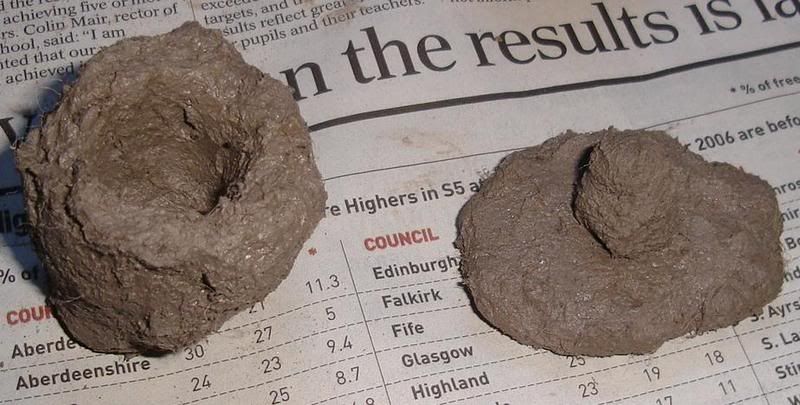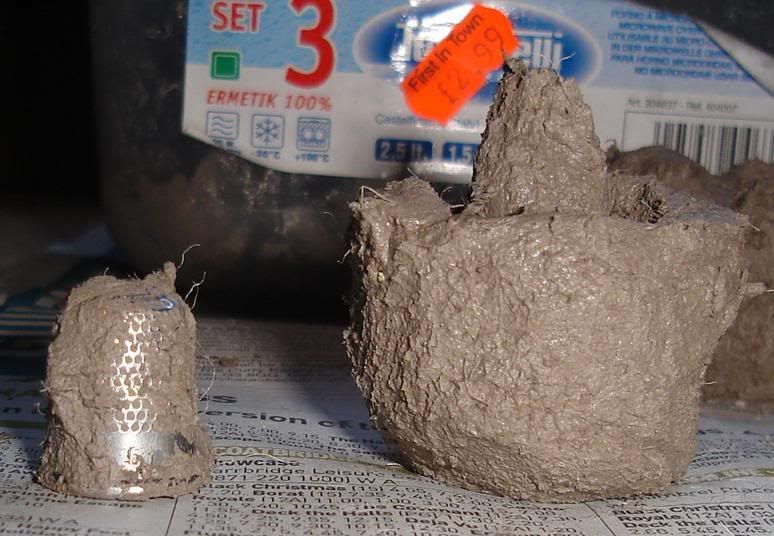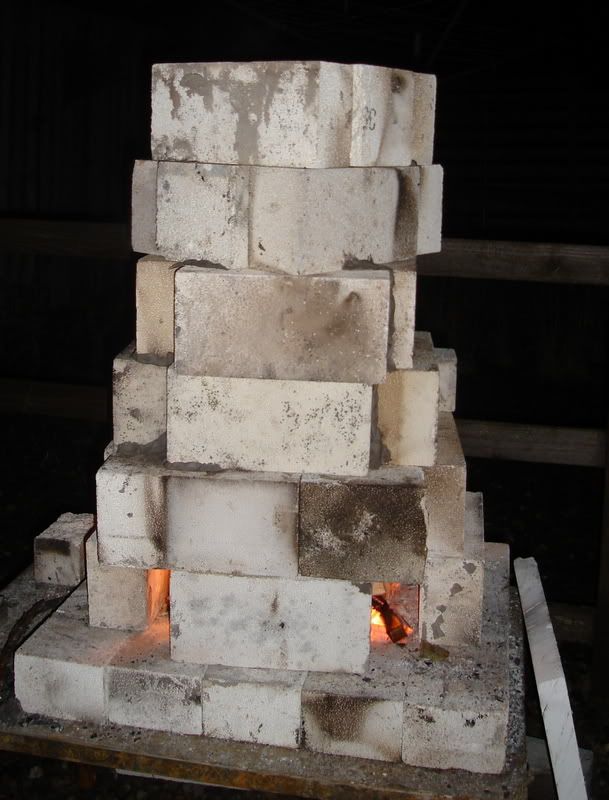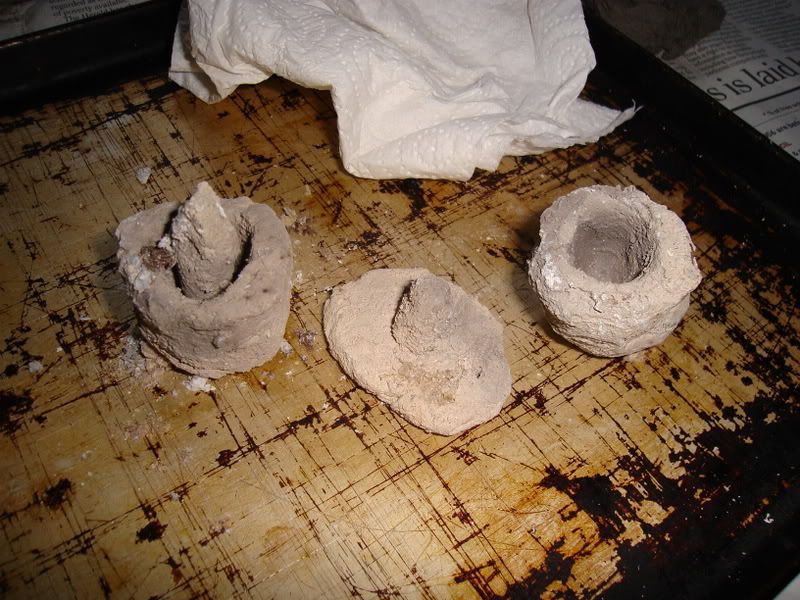I have been bandying various names around without giving much information about where they are from. So I shall provide some more information here, and ISBN numbers.
To start with, we have Theophilus, “On divers arts”
This was a manuscript, made up of 3 books, from the 12th century AD. The evidence available suggests they were written by Roger of Helmarshausen, a Benedictine monk working around 1100 onwards in Germany.
The edition I have is the Dover edition, ISBN – 0-486-23784-2, paperback, translated by John G Hawthorne and Cyril Stanley Smith in 1963.
The book is made up of thee books, on the subjects of painting, glass and metalwork. Each book is laid out clearly, starting with the materials necessary to get started, for example, the chapter on glass starts with building the furnace necessary, and near the end has instructions on making lead cames to hold the window together.
The instructions can be fairly readily understood, certainly they are not really inferior to some of the experimental instructions I came across in my chemistry degree.
Then there is “De Re Metallica” by Georgius Agricola. This is the first real treatise employing what we would nowadays think of as the sensible techniques of observation and personal experience, covering areas of mining work, metal working, and mineralogy. This is again a Dover edition, ISBN 0-486-60006-8, translated by Herbert Clark Hoover and Lou Henry Hoover. Yes, it was translated by a former president of the USA. Were that all current and former presidents were as useful and widely interested.
The importance of the book, first printed in 1556, was such that it remained the only authoritative work in the area of mining, according to the blurb on the back. That is some reccomendation.
Next is “De Pirotechnia” of Vannoccio Biringuccio. This was published in 1540, earlier than Agricola, but although it covers some of the same ground, it is less based upon observation, and also has less detail, thus its importance was less. On the other hand the blurb on the back describes it as the first clear, comprehensive work on metallurgy. But for some reason you hear less about Biringuccio, despite it being quite a handy wee book, and for what I am doing, is actually more useful.
My edition is another Dover one, ISBN 0-486-26134-4, translated by Cyril Stanley Smith and Matha Teach Gnudi, who translated it from Italian, Biringuccio being Siennese.
Finally, we have “Il libro dell’Arte” by Cennino d’Andrea Cennini, translated by Daniel V. Thompson, jr. Another Dover book, ISBN 0-486-20054-X. This book is about painting, as written by Cennini in 15th century Florence (According to the back cover. A more modern information source cites it as written in 1390). As such it is not much related to what I am doing, but will likely be useful as a short reference work and to give a better idea of what people were doing with materials in the later medieval period, not to mention it being another book which gives proper, useful instructions that a modern artist should be capable of understanding.
The first 3 are the main books I am relying on for first hand evidence of medieval technology. It is a shame that we do not have much from the 14th and 15th centuries.
The four books are also treasure troves of information in the form of footnotes on many pages, put in by the translators. These help clarify odd bits in the text, and will sometimes wander off at a historical tangent, and discuss all the techniques for manufacture of vitriol, for example. Without them my understanding would be much less.
There are various alchemical texts know from all through the medieval period, however they are by their nature not very informative, and translations are difficult to come by. I would need to find back copies of the journal “Ambix”, published by The Society for the History of Alchemy and Chemistry. Their url is:
There are various alchemical texts know from all through the medieval period, however they are by their nature not very informative, and translations are difficult to come by. I would need to find back copies of the journal “Ambix”, published byThe Society for the History of Alchemy and Chemistry
They have been on the go for decades, and built up a good lot of knowledge.
My main source on Alchemy just now has been “The Alchemists” by F Sherwood Taylor. Published in 1952, ISBN 586 08224 7, its author was Director of the Science Museum and honorary editor of Ambix, the journal of the aforementioned Society for the History of Alchemy and Chemistry. See how important the society is?
I also have a similar book by A J Holmyard, but can’t find it just now.
Another important (to me anyway) organization is The Historical Metallurgy Society, which can be found here:
http://hist-met.org/
I joined the society last year, and in its journal, volume 40 part one for 2006, found a translation of an 11th century text, written by a Greek, called “On the Noble and Illustrious Art of the Goldsmith”. Its an interesting article, since it also covers some ways of making metal objects look like gold, as well as alloying of gold with various metals.
Plus, an even bigger bonus is that the article comes with a list of texts that mention goldsmithing and things to do with metals. The list goes from the circa 1370BC Amarna tablets, via Theophrastus in 305BC, Zosimos, some Arabs, Theophilus, Geber, Biringuccio and up to some anonymous 18th century texts.
I have also purchased a number of back issues of their journals, which have been really informative on the subject of metal working through the ages.
Finally, on alchemy, there are many websites around. Most look really dodgy, full of strange pseudo religious philosophical mumbo-jumbo, or new age wishful thinkin. This one at least has a wider coverage and doesn’t seem to sit in judgement on it all:
http://www.levity.com/alchemy/physical.html
It contains many articles, some translations, much of the history of Alchemy etc. There is so much there that I do not know my way around it yet.
To sum up- there is a fair bit of information out there, it is just hard to find. Everyone on the internet has heard of X, and knows of Y, but for reasons of accuracy and knowledge I need to have the original sources. Internet sources are not always to be trusted. But getting hold of proper academic works and historical texts is hard, but nowadays a lot easier than in the early days of re-enacting. But now I have enough information to get on with things, and I will do so this very weekend.
Saturday, February 10, 2007
Manufacture of clay moulds for casting
I have been itching to start casting bronze or brass. However I could not decide what to make. Fortunately I am getting quite a large collection of pictures of medieval objects, and I settled upon thimbles to start off with. Small and fiddly, but then I would not have to melt too much metal. I could also experiment with the best mixture of clay and other ingredients. This is where it gets tricky.
Making moulds out of clay for objects is annoyingly poorly described. No doubt each master had his own specific recipes; these would probably vary by geography given the availability of local ingredients. Biringuccio, in his “Pirotechnia”, from 1540, is quite specific about all this. He says:
“There are many kinds and varieties of earth that are used for the loam compositions for making the moulds for casting bronze, brass, or other metals. Since this is a very necessary thing, you must try to have the best kind and one that resists the fire well. It must be disposed to receive the metals well, must make a neat casting, and must not shrink or break with cracks on drying or baking. Aside from actual trial, I believe that there is little that can help you, since the clay in itself has no colour or visible sign that I know of to show how satisfactory it is.”
Or in other words, whether it is red, or yellow, or brown, it is not clear as to exactly what kind of clay you should use, but the final product will be obviously good or bad. Difficulties of knowing exactly what to use are compounded by the fact that there is a translators note at the bottom of the page:
“Terra this word was used for earthy materials in general as well as specifically for clay such as used in moulding. We have used either earth or clay as seemed best fitted to the context.”
Or in other words, is Biringuccio talking about earth with much organic material in it, or just for clay? How much sand is in it? Further on he talks about using wool cloth clippings, wool cardings, and sand, iron scale, crushed brick, horse or donkey dung and a variety of other materials. All of these would add some strength to the clay, assuming we are talking about pure clay here. This pure clay would have to be smooth and lacking in lumps and bits of stone, in order to avoid voids and weak spots in the mould. This is easy for me to get nowadays, but much harder for people in the past. Also Biringuccio says it should not be unctuous or lean, characteristics that are somewhat unclear in the context of a book. Perhaps with samples in front of me they would make perfect sense. Also, he appears not to like the use of pure clay, saying “In conclusions, with the exception of pure clay (which is too viscous and tenacious), any other earth, if free from pebbles, could easily serve you by tempering it with others, or if it should have pebbles, by separating them out.”
Biringuccio was greatly enamoured of wool clippings for helping the clay stay good and strong. They would act like a composite, giving greater strength through having these small fibres running through the clay. But there is nothing about how long they would be. I suspect they would be a few mm, but it is not clear. So I shall have to experiment.
I cut up some wool I gathered from fences and ended up with fibres 2 or 3mm long. Together with fine grained sand from the local sandpit, and and buff clay, with a bit of charcoal and some of the strange ashes you get from charcoal briquettes. (Charcoal briquettes are rubbish for my purposes, since they do not burn fast enough.) I have no idea if anything is special about buff clay, but it seems to work, and some googling suggests it is good for modelling etc.
Clay is sticky stuff when wet. I had trouble getting it to stop sticking to my fingers, next time I shall use much dryer clay. Again, from the old books it is not clear how wet it should be. I managed to make two kinds of mould for thimbles. The first, is made of two parts. The aim was to have a top, with a lump sticking down from it to fill in the hollow in the bottom part. This kind of worked, but I forgot to put in the pouring holes so shall have to drill them out. The second kind was made of a hollow, with a lump placed into the middle of it. The aim was to mimic medieval thimbles. The earlier kind, that the second mould is made for, had a hole in the top. Now, I have yet to find any mention of why this is, but the easiest way I can think of making a thimble with a hole in the top is by making a mould like I have done. Since the centre of the thimble has to be there to ensure it is a ring of metal, it seemed easiest to have a piece of clay running through that point.
Earlier thimble with hole in top (14th C or so):
Eraly medieval thimble
Later medieval thimble, more like today’s (15th century):
Later medieval thimble
My moulds:
The first mould

The second mould:

There is a thimble beside it for comparison.
Now, I dried these moulds in a warm but not hot oven for an hour or two, then ramped up the temperature to over 100C for an hour. They were then fired to something towards 600C in this set up:

I was experimenting with chimneys, so built it high. The gaps at the side had some clay on them, to seal it off a bit better to ensure that it worked as chimney. Maybe I made it close in too much at the top, but it didn’t work quite as well as last time. Part of the problem was that I was using wood that wasn’t quite dry enough, and was quite green. So it didn’t take off too well. But the thermocouple registered just over 800C in the embers when it was going properly. For the chimney effect to work properly I need a good lot of heat at the bottom, to heat air and provide combustion gases, thus pulling more air in at the bottom. You end up with lots of air getting to the fire for no other reason than the fire itself. From the description of a similar set up in Theophilus, mine was not good enough, it should be able to reach a temperature of over 900, which is what is needed for making brass.
They came out fine, looking like this:

No cracking apparent. I shall still put them in the furnace at over 1000 when I’m melting the copper, just to make sure that they are properly fired.
After I’d made my clay moulds, I found a comment in the journal of the Historical metallurgy society, 30/2, 1996, page 112, saying that the mould material they had found on an archeological dig was clay tempered by organic matter. Yes, great, but what kind of organic matter? I shall probably have to try leaves, potting compost, and plain old earth.
It is likely that there are some people out there doing this using nearly authentic techniques, but half the fun of this is working it out for myself, and at the end I shall have a much better idea of what makes things work well when doing historical metallurgy.
Update on my Spanish Green experiment- after 2 days, the copper in the vinegar solution has not turned green, but the copper above it has done so. This suggests that the main reason it will turn green is reaction with acetic acid vapour. Copper acetate being the result. So for larger scale production, it shall be necessary to merely heat vinegar gently, with copper suspended above it. Why didn’t they use this method then?
Making moulds out of clay for objects is annoyingly poorly described. No doubt each master had his own specific recipes; these would probably vary by geography given the availability of local ingredients. Biringuccio, in his “Pirotechnia”, from 1540, is quite specific about all this. He says:
“There are many kinds and varieties of earth that are used for the loam compositions for making the moulds for casting bronze, brass, or other metals. Since this is a very necessary thing, you must try to have the best kind and one that resists the fire well. It must be disposed to receive the metals well, must make a neat casting, and must not shrink or break with cracks on drying or baking. Aside from actual trial, I believe that there is little that can help you, since the clay in itself has no colour or visible sign that I know of to show how satisfactory it is.”
Or in other words, whether it is red, or yellow, or brown, it is not clear as to exactly what kind of clay you should use, but the final product will be obviously good or bad. Difficulties of knowing exactly what to use are compounded by the fact that there is a translators note at the bottom of the page:
“Terra this word was used for earthy materials in general as well as specifically for clay such as used in moulding. We have used either earth or clay as seemed best fitted to the context.”
Or in other words, is Biringuccio talking about earth with much organic material in it, or just for clay? How much sand is in it? Further on he talks about using wool cloth clippings, wool cardings, and sand, iron scale, crushed brick, horse or donkey dung and a variety of other materials. All of these would add some strength to the clay, assuming we are talking about pure clay here. This pure clay would have to be smooth and lacking in lumps and bits of stone, in order to avoid voids and weak spots in the mould. This is easy for me to get nowadays, but much harder for people in the past. Also Biringuccio says it should not be unctuous or lean, characteristics that are somewhat unclear in the context of a book. Perhaps with samples in front of me they would make perfect sense. Also, he appears not to like the use of pure clay, saying “In conclusions, with the exception of pure clay (which is too viscous and tenacious), any other earth, if free from pebbles, could easily serve you by tempering it with others, or if it should have pebbles, by separating them out.”
Biringuccio was greatly enamoured of wool clippings for helping the clay stay good and strong. They would act like a composite, giving greater strength through having these small fibres running through the clay. But there is nothing about how long they would be. I suspect they would be a few mm, but it is not clear. So I shall have to experiment.
I cut up some wool I gathered from fences and ended up with fibres 2 or 3mm long. Together with fine grained sand from the local sandpit, and and buff clay, with a bit of charcoal and some of the strange ashes you get from charcoal briquettes. (Charcoal briquettes are rubbish for my purposes, since they do not burn fast enough.) I have no idea if anything is special about buff clay, but it seems to work, and some googling suggests it is good for modelling etc.
Clay is sticky stuff when wet. I had trouble getting it to stop sticking to my fingers, next time I shall use much dryer clay. Again, from the old books it is not clear how wet it should be. I managed to make two kinds of mould for thimbles. The first, is made of two parts. The aim was to have a top, with a lump sticking down from it to fill in the hollow in the bottom part. This kind of worked, but I forgot to put in the pouring holes so shall have to drill them out. The second kind was made of a hollow, with a lump placed into the middle of it. The aim was to mimic medieval thimbles. The earlier kind, that the second mould is made for, had a hole in the top. Now, I have yet to find any mention of why this is, but the easiest way I can think of making a thimble with a hole in the top is by making a mould like I have done. Since the centre of the thimble has to be there to ensure it is a ring of metal, it seemed easiest to have a piece of clay running through that point.
Earlier thimble with hole in top (14th C or so):
Eraly medieval thimble
Later medieval thimble, more like today’s (15th century):
Later medieval thimble
My moulds:
The first mould

The second mould:

There is a thimble beside it for comparison.
Now, I dried these moulds in a warm but not hot oven for an hour or two, then ramped up the temperature to over 100C for an hour. They were then fired to something towards 600C in this set up:

I was experimenting with chimneys, so built it high. The gaps at the side had some clay on them, to seal it off a bit better to ensure that it worked as chimney. Maybe I made it close in too much at the top, but it didn’t work quite as well as last time. Part of the problem was that I was using wood that wasn’t quite dry enough, and was quite green. So it didn’t take off too well. But the thermocouple registered just over 800C in the embers when it was going properly. For the chimney effect to work properly I need a good lot of heat at the bottom, to heat air and provide combustion gases, thus pulling more air in at the bottom. You end up with lots of air getting to the fire for no other reason than the fire itself. From the description of a similar set up in Theophilus, mine was not good enough, it should be able to reach a temperature of over 900, which is what is needed for making brass.
They came out fine, looking like this:

No cracking apparent. I shall still put them in the furnace at over 1000 when I’m melting the copper, just to make sure that they are properly fired.
After I’d made my clay moulds, I found a comment in the journal of the Historical metallurgy society, 30/2, 1996, page 112, saying that the mould material they had found on an archeological dig was clay tempered by organic matter. Yes, great, but what kind of organic matter? I shall probably have to try leaves, potting compost, and plain old earth.
It is likely that there are some people out there doing this using nearly authentic techniques, but half the fun of this is working it out for myself, and at the end I shall have a much better idea of what makes things work well when doing historical metallurgy.
Update on my Spanish Green experiment- after 2 days, the copper in the vinegar solution has not turned green, but the copper above it has done so. This suggests that the main reason it will turn green is reaction with acetic acid vapour. Copper acetate being the result. So for larger scale production, it shall be necessary to merely heat vinegar gently, with copper suspended above it. Why didn’t they use this method then?
Subscribe to:
Posts (Atom)